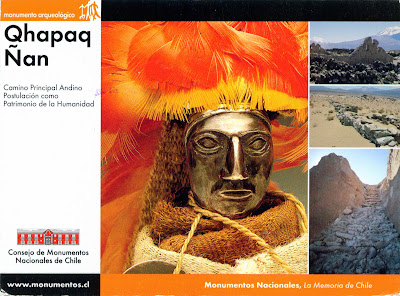October 28, 2013
0852 CHILE - Qhapaq Ñan, Andean Road System (UNESCO WHS)
It is known that the Inca road system was the most extensive and advanced transportation system in pre-Columbian South America. The network was based on two north-south roads with numerous branches, the best known portion of it being the trail to Machu Picchu. Part of the roads was built by cultures that precede the Inca Empire, notably the Wari culture, and during the Spanish colonial era parts of this system were given the status of Camino Real (Royal Road). Imagine stone paving up to 20m wide, dressed steps climbing heights of over 4500m, walkways over water and suspension bridges spawning raging rivers. Envision single runners, chasquis, carrying messages on knotted strings called quipus at lightening speed in relay from one end of the empire to the other or imagine thousands of troops marching in line, their footsteps thundering in approach. Or visualize the Inca himself, seated on a litter lined with feathers and plated with gold and silver, being carried by more than 80 lords, the road before him being swept and adorned with petals.
The Inca road system linked together about 40,000km of roadway along the spine of the Andes. The eastern route (Camino Real) ran high in the puna grasslands and mountain valleys from Quito, Ecuador to Mendoza, Argentina. The western route followed the coastal plain not including in coastal deserts where it hugged the foothills. More than twenty routes ran over the western mountains, while others traversed the eastern cordillera in the mountains and lowlands. The trails connected the regions of the Inca Empire from the northern provincial capital in Quito, Ecuador past the modern city of Santiago, Chile in the south. Actually the true extent of the road network isn't completely known, today only 25% being still visible, the rest having been destroyed by the construction of modern infrastructure. For example, as Hernan wrote, "the current Bandera Street (in the center of Santiago) was the Qhapaq Ñan and today they're building line 3 of Metro de Santiago".
Argentina, Bolivia, Chile, Colombia, Ecuador and Peru share this cultural heritage, included in 2014 among UNESCO World Heritage List as Qhapaq Ñan, Andean Road System. In the postcard are depicted a silver human figurine (found in the Sanctuary Altura del Cerro El Plomo), Pucará de Turi, Tambo Colorado archaeological site, and Caspana archeological site.
About the stamps
The first stamp is part of a very special series illustrating paintings by Roberto Matta, about which I wrote here. The last two ones are part of the series Valparaíso, Patrimonio de la Humanidad, about which I wrote here.
References
Inca road system - Wikipedia
Qhapaq Ñan, the grand route of the Incas - a website by Laurent Granier and Megan Son
Qhapaq Ñan, Andean Road System - UNESCO official website
Sender: Hernán (direct swap)
Sent from Santiago (Santiago Metropolitan Region / Chile), on 30.07.2013
Photo: Fernando Maldonado
Subscribe to:
Post Comments (Atom)


No comments:
Post a Comment